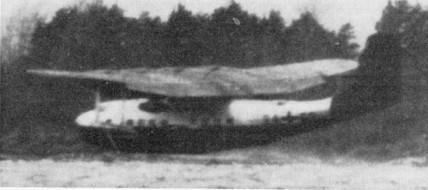
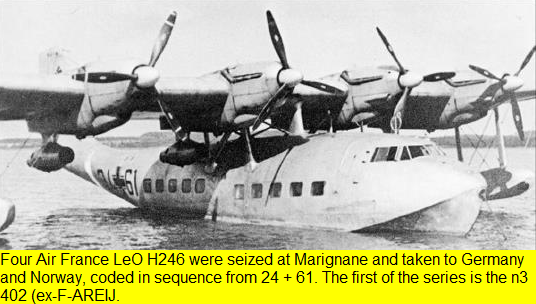

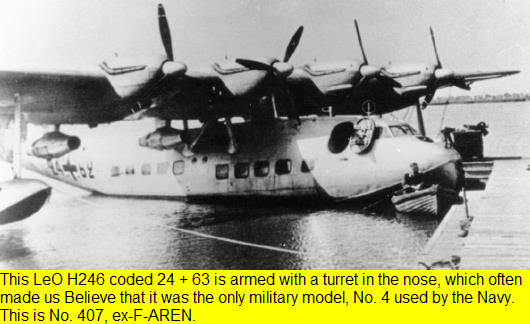
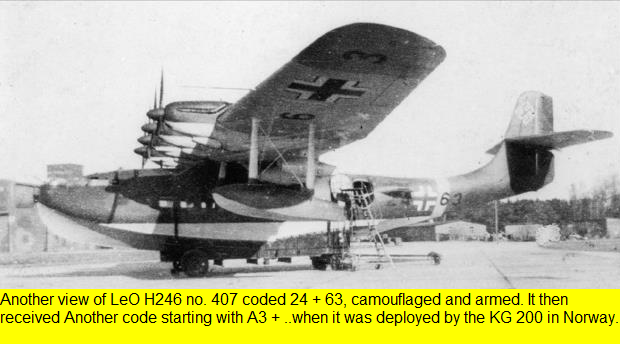
The LeO H-246 was designed by the French aircraft manufacturer Lioré-et-Olivier to meet a 1935 specification for a commercial flying boat for use on the Mediterranean routes of Air France. It was a four-engined parasol monoplane of mixed construction and powered by four 720 hp (537 kW) Hispano-Suiza 12Xir liquid cooled V12 engines. All four engines were mounted in streamlined nacelles ahead of the leading edge of the wing. It had a duralumin hull which was of similar layout to that of Lioré et Olivier's H-47; it had seats for 26 passengers, and a crew of four.
The prototype H-246.01 (Lioré et Olivier's factories had been nationalised at the end of 1936, so the aircraft was built by Sud-Est) made its maiden flight from the Étang de Berre on 30 September 1937. Air France placed an order for six H-246.1 aircraft in January 1938, with the prototype also being brought up to production standard for commercial service.
The refurbished prototype and the first production aircraft were being readied for commercial service when the Second World War broke out in September 1939. The French Navy drew up plans to requisition the H-246s as maritime patrol aircraft, but Air France still needed them, and the Navy agreed to take over only four of the aircraft. This allowed Air France to commence operations with the prototype on the Marseille-Algiers route on 14 October 1939.
The third production aircraft was completed for the Navy in June 1940, with a glazed position in the nose for a bombardier/navigator, bomb racks below the wings and four 7.5 mm Darne machine guns as defensive armament. It entered service with Escadrille 9E on 25 August 1940, the only aircraft of the type actually to be operated by the French Navy, with the remaining aircraft going to Air France.
In November 1942, the Allies landed in French North Africa and, in response, German forces occupied Vichy France. They seized the single French Navy H-246, along with three Air France aircraft. Two more Air France aircraft were at Algiers at the time and so escaped seizure by the Germans. (The prototype H.246 had been withdrawn from use in 1941).
The German Luftwaffe took over the three seized ex-Air France aircraft, fitting them with five MG 15 machine guns as defensive armament and carrying up to 21 soldiers or 14 stretchers. The aircraft were used for various tasks, including transport in Finland. A sixth copy, belonging to the Navy, was stored at Berre, but it was not taken away by the Germans. One of the four planes seized was destroyed at the same time as the SE-200 and the Laté 631 on April 7, 1944, on Lake Constance, during an attack by a Mosquito of an unidentified unit of the RAF. At least two of these seaplanes were used by 3 / KG 200, under unit codes A3 + KC and A3 + HC. The last three LeO H246 operated in Finland
The ex-French Navy H-246 was destroyed at Lyon by Allied attacks in the spring of 1944. After the war, the two surviving H-246s were used by Air France to restart the Marseille-Algiers service, continuing in use until September 1946.


In 1935, Lior et Olivier began working on a 26-seat passenger flying boat, designed for use on Mediterranean routes. The requirements for its design were listed in the terms of reference issued on February 27 of the same year. The boat, named LeO H.246.1 , had a mixed design and was equipped with Hispano-Suiza 12Xirsl / Xjrsl engines
The H 246 resembled the H 470 and was about the same size, but with lower overall flight weight and reduced performance. However, the two types of aircraft differed in a number of basic ways. Wing H 246 had a solid wood structure and all four engines were installed in front of the leading edge of the wing.
The two-spar wing mounted above the hull on the pylon had constant chord and thickness in the section between the engines, however, the outer parts had a tapering chord and thickness, as well as a transverse V angle. The flaps and ailerons were located on the trailing edge throughout the entire wing span, including number and above the body. The wing was divided into several waterproof compartments and had plywood sheathing, but the flaps and ailerons had a duralumin structure and were covered with a canvas. It was stated that the wing would keep the plane afloat even with a damaged body.
The two-part hull made of duralumin seems to be similar in design to the H 470 fuselage. Like the H 470, the strutted stabilized floats were located approximately in the middle of the wing span.
It appears that the tail design was identical to the tail design of the original H 47 before it was modernized. The surfaces of the tail have a duralumin design with a coating of deflected surfaces. As in the case of H 47, the rudder was divided into upper and lower sections.
The power plant consisted of four 720-horsepower, twenty-cylinder Hispano-Suiza 12Xir V-shaped water-cooled engines that rotated Hispano-Hamilton three-blade variable pitch propellers. The engines were carefully capotated; under each gondola, the engines were located quite far behind radiators of circular cross section.
The enclosed cockpit of the H 246 was much closer to the bow than the H 47. The hull was quite deep, and the pilots sat at a higher level than the passenger compartment. The right front of the fuselage had a mooring compartment, then there was a cockpit with seats sitting side-by-side pilots, behind which were the cockpit of the navigator and radio operator. The passenger room was divided into two parts by a toilet located on the starboard side and a bar located on the port side. In the bow on the starboard side there were eight seats, in two compartments arranged in pairs facing each other. In the front part on the left side there was another pair with twin seats facing each other, behind them was a pair of seats looking back. In total, there were 14 passenger seats in the front. In the rear part on the starboard side there were two compartments with seats facing each other, on the port side there were four single forward looking seats. Behind the passenger compartment were luggage and cargo compartments. The entrance faith was located on the port side behind the passenger compartment. There were ten windows on each side. A separate door for the crew was located in the front on the starboard side.
Prototype H 246 made its first flight on September 30, 1937 from Lake Etang de Berre, not far from Marseille. The aircraft was registered as F-AOUJ (serial number 01) and was later named Maroc.
In January 1938, Air France, in addition to the prototype, ordered six more LeO H 246. They were supposed to carry 26 passengers and were intended for trans-Mediterranean routes connecting Marseille with Algeria, Tunisia and Tripoli (a city in northern Lebanon). As in the case of H 47, the prototype H 246 was severely damaged during tests in a stormy sea, as a result of which the hull had to be strengthened. This led to a change in aircraft type designation to H 246-1.
When the war began, the first production aircraft and prototype were preparing for commissioning. Six serial boats were registered and named F-AREI Senegal, F-AKEJ Mauritanie, F-AREK, F-AREL Oranie, F-AREM Algerie and F-AREN Tunisie (serial numbers 402-407). The third began to be converted into a naval scout. The cockpit of the navigator-bombardier was provided in the bow; under the wing between the nacelles - the placement of bomb racks. . As such, the third production boat made its first flight on June 21, 1940. A few days later she flew to Burr to install weapons on August 25, the plane to squadron 9E. The plane was in Burra when the Wehrmacht occupied the territory under the control of the Vichy government. Her further fate is unknown.
Other machines, until November 8, 1942, were operated by Air France on the Marseille-Algeria route. At least three LeO H 246 (F-AREI, F-AREM and F-AREN) were captured by the Luftwaffe in Marignan (Marseille) and delivered to Germany, but the F-AREJ and F-AREL in Algeria escaped immediately after the war flew along the route Marseille-Algeria. It was reported that the F-AREK, which hit the fleet, was destroyed in the spring of 1944 during the Allied attack on Lyon.
French reports say that the first LeO H 246 F-AOUJ was put into operation on October 14, 1939 and flew on the Marseille-Algeria line with 27 passengers, 540 kg of cargo and 409 kg of mail. By April 1941, the aircraft flew for 888 hours, but for some reason at the end of this year it was decommissioned. Apparently, the two LeO H 246 aircraft remaining at Air France were decommissioned in September 1946, flying F-AREJ - 1079 hours and F-AREL - 1459 hours.
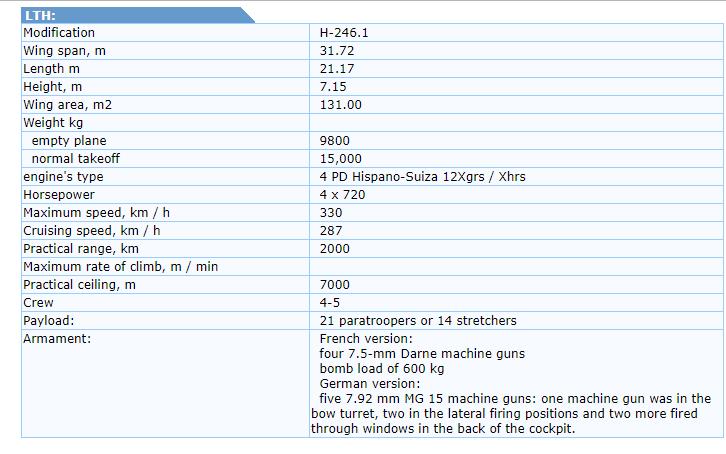
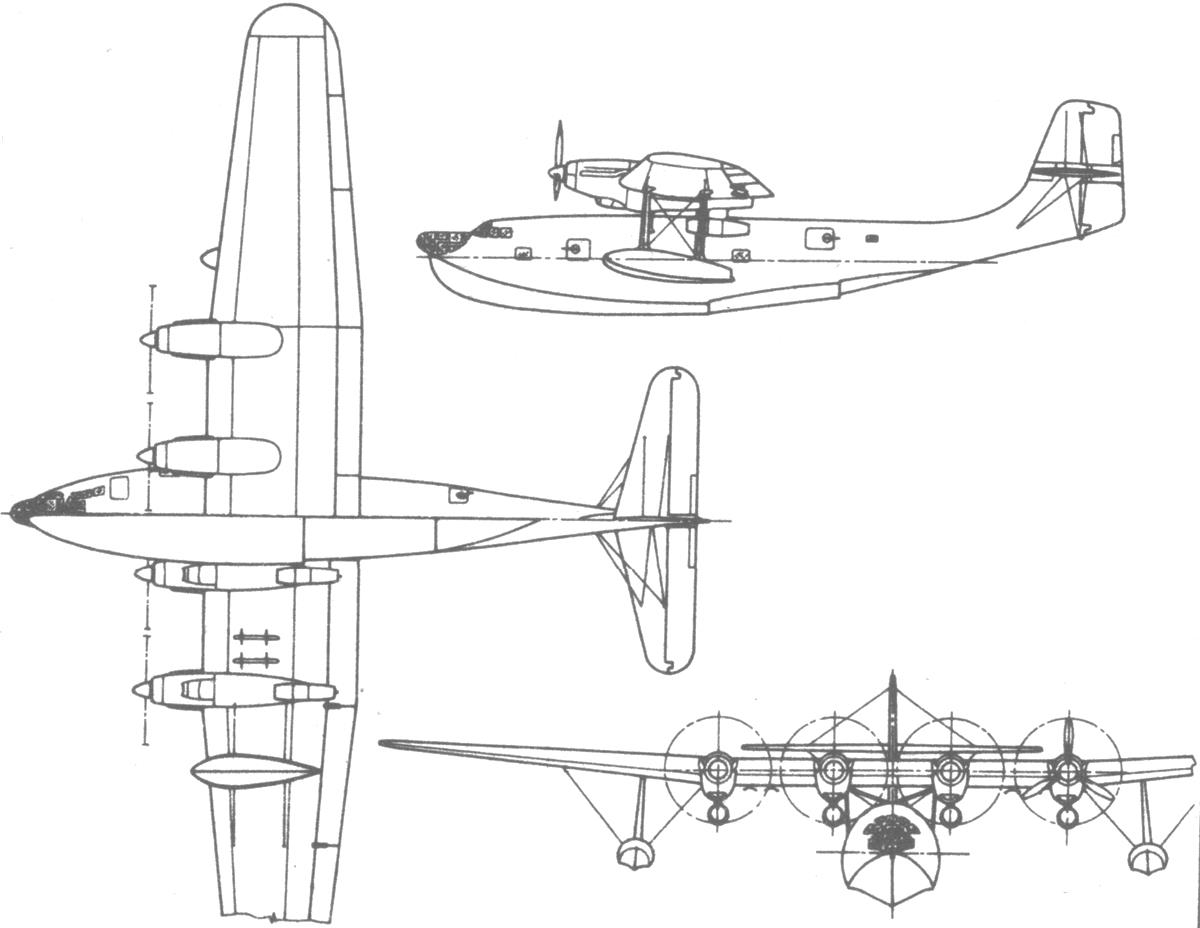
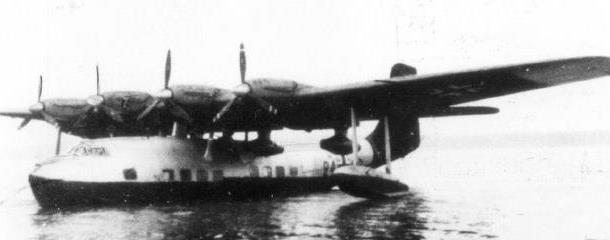
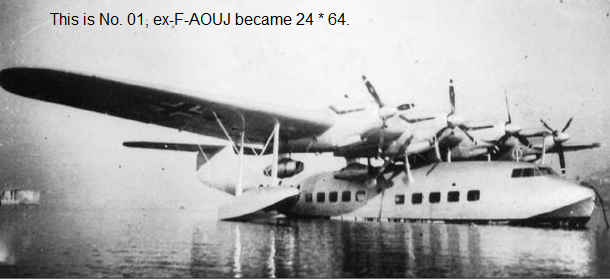
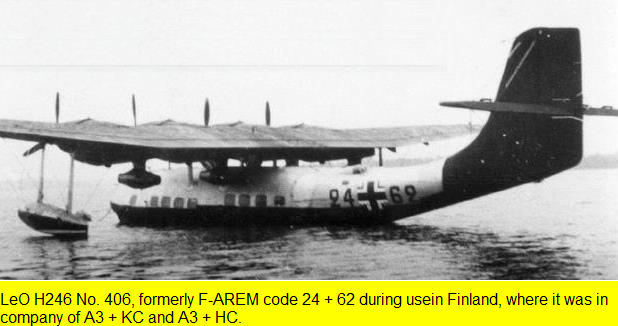

| Type |
Crew 4-5, 26 passengers or 21 Soldiers or 14 stretchers |
| Engine |
4 Hispano-Suiza 12Xirs wih Hispano-Hamilton three-blade variable pitch propellers |
| Dimensions |
Length 21,17 m , height 7,15 m , span 31,72 m , wing area 131 m2 , |
| Weights |
Empty 9800 kg, loaded , max. take off weight 15000 kg |
| Performance |
Max.. speed 330 km/h , cruising speed 255 km/h , range 2000 km, endurance , service ceiling 7000 m , climb |
| Armament |
5 MG 15 machine guns |
| Type |
Werk.Nr |
Registration |
History |
| A |
402 |
F-AREI, 24+61, A3+KC, AE+HC |
To Erprobungsstelle Travemünde 3 August 1943, later to 3./KG 200 |
|
406
|
F-AREM, 24+64, A3+EC ? |
To Erprobungsstelle Travemünde,l ater to 3./KG 200 |
|
407 |
F-AREN. 24+63 |
To Erprobungsstelle Travemünde, later to 3./KG 200 |











